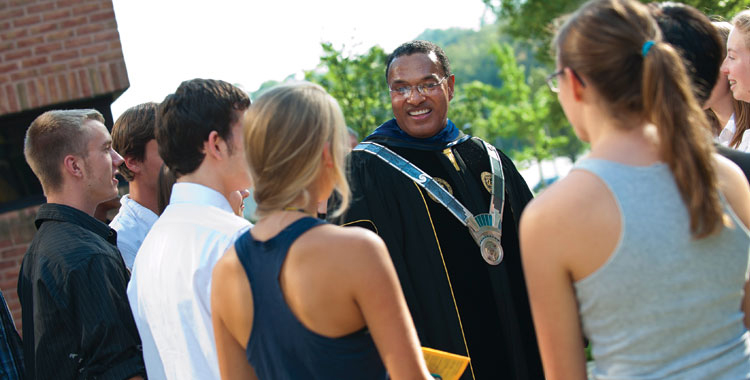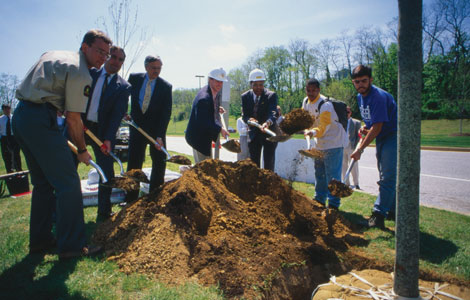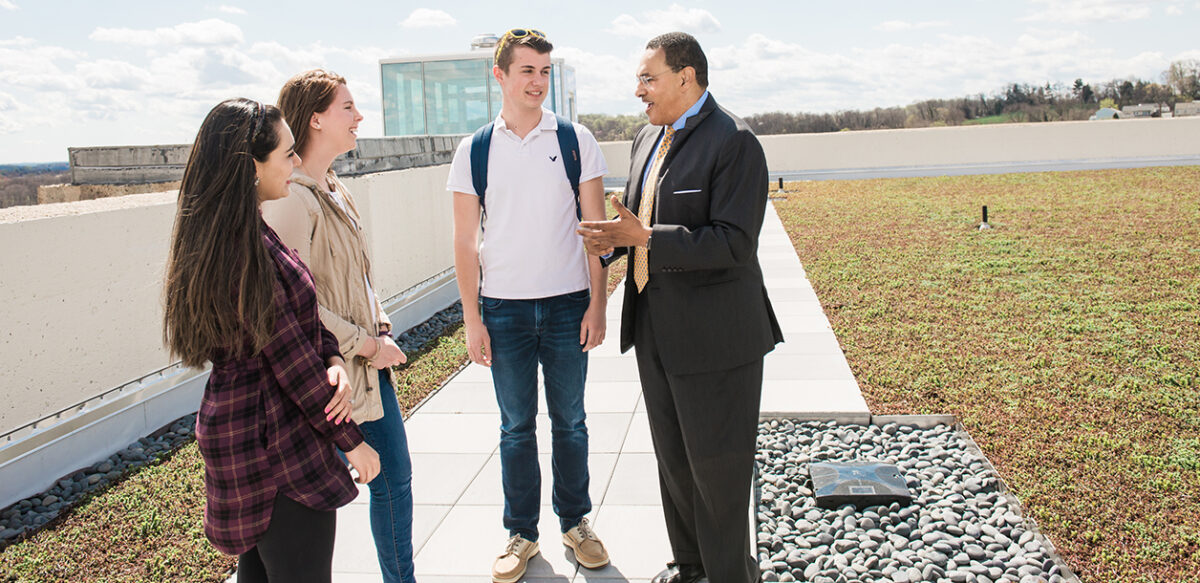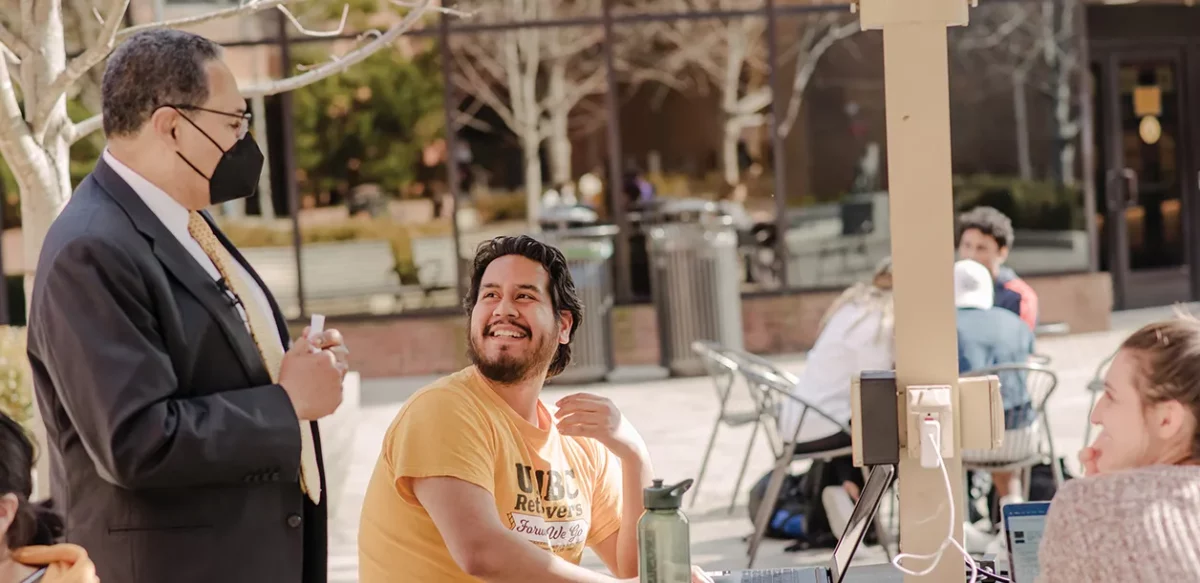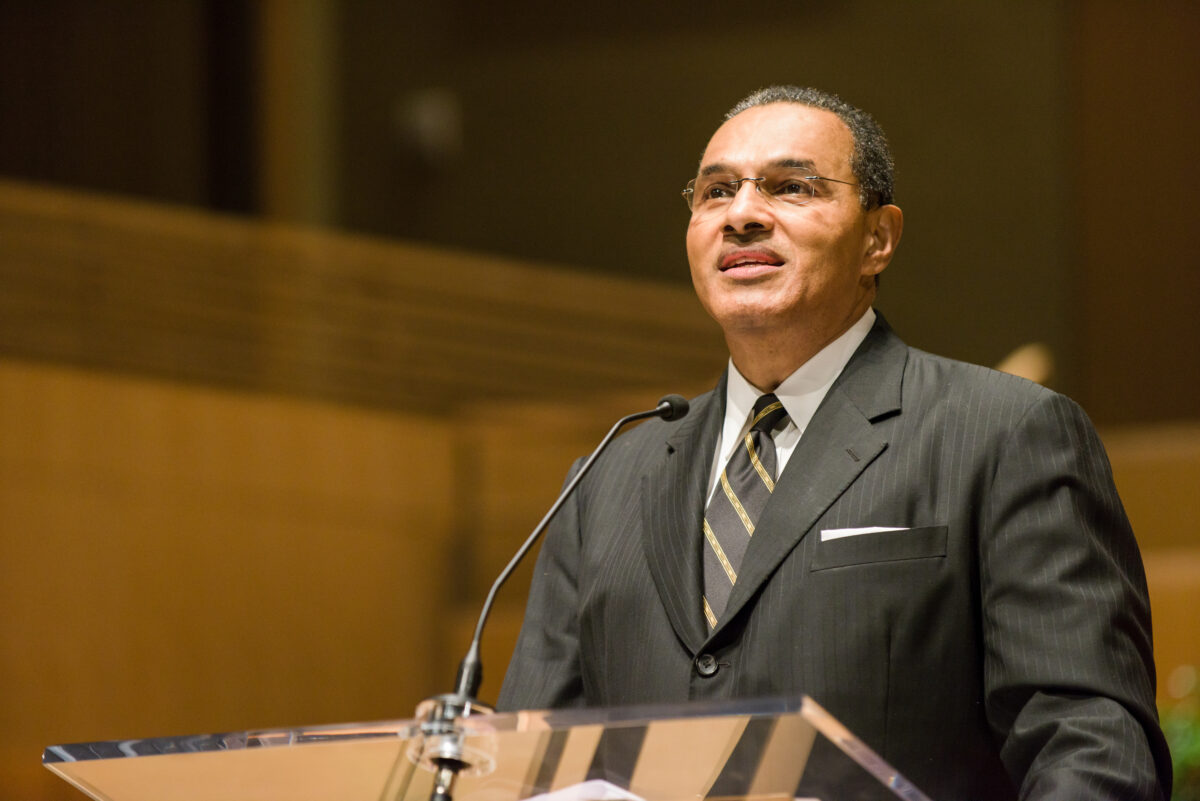Twenty years ago, UMBC sought a greater academic reputation and a deeper sense of community. It advanced both goals under the leadership of President Freeman A. Hrabowski, III.
By Richard Byrne ’86
Giving name to your aspirations is often the first step to achieving them. And back in 1995, the words that campus leaders summoned to encompass their hopes for UMBC were “An Honors University in Maryland.”
The university was just shy of its 30th anniversary and only three years into the tenure of its fifth president, Freeman A. Hrabowski, III. UMBC already possessed institutional strengths, including its stellar faculty, the pioneering spirit that comes with being a young university, and an increased dynamism and connection with its closest cities – Baltimore and Washington, D.C. – bequeathed to it by Hrabowski’s predecessor, Michael Hooker. (See “Up on the Roof”)
What UMBC needed at that moment was an audacious imaginative leap: an identity that would help the campus seize upon the university’s strengths, elevate them, and create a more deeply knit community.
“I think the campus agreed,” Hrabowski recalls, “that we needed to attract more students who could take advantage of what we had to offer – even as we worked to think about the learning process and engage students in research.”
Twenty years into Hrabowski’s presidency, UMBC has undergone a profound transformation. The university is now renowned for nurturing young minds in an environment that values excellence, innovation, and diversity. Its investments to retain and attract top-notch faculty have paid off not only in rising prestige and research funding, but also in a reputation for providing undergraduates with a superlative environment for learning. UMBC’s physical campus has been transformed in ways that have improved the university’s teaching and research infrastructure – as well as its aesthetic appeal and overall quality of life.
This metamorphosis at UMBC has been lauded by a national media that loves an unexpected success story. The university’s achievements have been praised in outlets including CBS’ 60 Minutes, Time magazine, The New York Times and The Washington Post. And while Hrabowski’s leadership is often spotlighted in these stories, Hrabowski likes to point out that UMBC’s successes often have been proposed, nurtured and pushed forward by UMBC’s faculty, students and staff in an atmosphere of shared governance.
John Jeffries, Dean of UMBC’s College of Arts, Humanities and Social Sciences and a former president of the Faculty Senate, observes that “shared governance has always been vital and important at UMBC. It’s been a fundamental part of the health and progress of UMBC in the past two decades.” Jeffries adds that Hrabowski “meets regularly with the Faculty Senate president, brought the Faculty Senate president and Academic Planning and Budget Committee chair onto the Budget Committee and President’s Council, and works with the Faculty Senate. Shared governance has played a fundamental role in the progress of the academic programs.”
Looking back, the principles undergirding UMBC’s rise to prominence seem clear. Elevate academic excellence. Create spaces and opportunity to forge community. Bring the entire university into the processes of academic research and creative endeavor.
But how, exactly, did it all happen? As the campus celebrates two decades of Hrabowski’s leadership, it is now possible to trace more fully the arc of that evolution.
TAKING THE HONORS
UMBC’s efforts to attract the best students from Maryland and elsewhere had gathered steam by the end of the 1980s. Average SAT scores for freshmen entering UMBC in 1989 climbed above the national average – and subsequently those scores have skyrocketed to almost 200 points over the average.
Yet it took a certain degree of audacity to proclaim UMBC “An Honors University in Maryland” only six years after reaching that important milestone. But stating the university’s aspirations publicly was a key step in UMBC’s transformation.
“It was the marketing initiative that taught us that we had become known as a place for serious academic study,” recalls Hrabowski. “A university attracting more students from high school honor societies. A university that was sending a disproportionate number of students to graduate and professional schools. And, most important, that we were a public university that openly valued the life of the mind. All these things were part of the honors university concept.”
The concept of an honors university might have been new, but its foundations had been laid in previous years.
One essential element in UMBC’s reimagination of itself was the creation of the Meyerhoff Scholars Program by Hrabowski (who had been recruited to UMBC in 1987 as vice provost by Michael Hooker) and philanthropist Robert Meyerhoff. The program aimed to increase the number of minority students pursuing graduate degrees in science, technology, engineering, and math (STEM) disciplines – and its success in doing so has made the program an international model for fostering excellence and diversity. The program’s more than 700 graduates have subsequently earned 81 Ph.D.s, 25 M.D./Ph.D.s and 92 M.D.s. – and many more of its graduates are still pursuing advanced degrees.
The Meyerhoff Program also created wider ripples at UMBC. Its formula of recruiting talented students and forging shared and structured intellectual communities was adopted (and adapted) elsewhere at the university. New programs including the Linehan Artist Scholars Program, the Sondheim Public Affairs Scholars Program, the Humanities Scholars Program, and the Center for Women In Technology (CWIT) were created to extend the values of academic excellence and shared enterprise across disciplines.
Such programs would not exist without a significant investment in UMBC’s innovation from a myriad of donors – including an increasing number of UMBC alumni who give back to their alma mater. UMBC’s first two capital campaigns for the university, which concluded in 2002 and 2011, each exceeded their goals by at least $15 million.
Baltimore businessman and philanthropist Earl Linehan was a co-chair of that first capital campaign – and also a longtime chair of UMBC’s Board of Visitors. When he was first invited to visit the university by Hrabowski, Linehan says that he was immediately impressed by the UMBC president’s “unbelievable energy and personal connection with the students.”
Yet Linehan says that he and the other donors who helped fuel UMBC’s transformation in that era also saw an institution that was ripe to make a big leap. “A lot of us initially were attracted by Freeman,” he continues. “But then we got to know the institution. Even then, the reality of the place already outshone the perception of it. We became inspired by the whole ethos of the place.”
And as UMBC found resources to advance its ambitions, its progress toward becoming an honors university was extended into every corner of the school by faculty and staff members who served on an Honors University Task Force that issued its final report in May 2000.
The task force aimed to extend “the rigorous ways of learning that are options for students in select programs at UMBC to a wider student body,” and identified changes to significantly strengthen and broaden both the curriculum and student support services. The task force offered crucial advice on implementing those changes, and its work has given talented students attracted by the honors university concept more pathways and support to achieve academic excellence at UMBC.
GIVE US TREES
Improving UMBC’s aesthetic appeal and creating new spaces to foster deeper community were on Hrabowski’s agenda from his earliest days as president. He fondly recalls his first meeting with the late William Donald Schaefer, who was Maryland’s governor when Hrabowski was named to the job.
“[Governor Schaefer] said to me, ‘What can I do to show people how proud I am of you and of the university?’ And I said, ‘Give us trees,’” Hrabowski recalls. “Because people said that this place would look better and better as the trees grew. And he was absolutely delighted to give us support.”
A year before Schaefer’s passing in 2011, Hrabowski invited Maryland’s former governor back to campus. “I reminded him of those trees,” he says. “He was amazed by how much we had developed, and moved that we were giving him credit for helping us to develop.”
Green campus spaces such as the Beuys Sculpture Park (just southeast of the Retriever Activities Center) are a tangible sign of UMBC’s aesthetic upgrade. And with a strong push from UMBC’s faculty, green spaces became part of the university’s research infrastructure when its Conservation and Environmental Research Areas (CERA) – contiguous to the long-planned bwtech@UMBC Research and Technology Park – were created in 1997.
In the midst of those green spaces, other sorts of growth took place. The addition to UMBC’s Albin O. Kuhn Library that opened in 1995 was underway when Hooker left the university.
And under Hrabowski’s leadership, 13 new buildings and 12 major additions and renovations to UMBC’s campus have been completed in the past two decades.
Much of this flurry of new construction – and the state funding that supported it – advanced both the research and teaching missions at UMBC.
“When I think about this growth,” says Hrabowski, “I think about the confidence that the state has in us as a major institution of learning. And I think about the areas that have been strengthened academically as a result. The physical transformation reflects a trend of growth in the academic program.”
The new buildings on campus created new opportunities for innovation across disciplines: a new Physics building, a new Public Policy building, two new Information Technology/Engineering buildings, and, just this autumn, a new Performing Arts and Humanities Building (See “The News”). UMBC also undertook major renovations of key structures in the natural sciences, overhauling the Biological Sciences and the Meyerhoff Chemistry buildings. And the opening of bwtech@UMBC in 2002 – a research park that is now home to nearly 100 companies that generate over $200 million annually in total business – created even closer collaborations with industry and commerce in the region.
UMBC’s building boom also focused squarely on creating deeper community on campus and encouraging students to call the school their home during the academic year.
The centerpiece of this effort was the 2002 opening of The Commons, a new university center that swung the center of campus closer to the residential heart of the school. And that heart has seen a boom of its own: two new apartment complexes, two new dormitories, and the refurbishment and expansion of other existing student residences.
“The development has emphasized the importance of community,” Hrabowski says. “Spaces like The Commons, and even the benches that we have on campus, are spaces that invite conversation, reflection and community – and the feeling that the university is becoming more residential.”
The creation of new community spaces and the growth campus housing have supported UMBC’s gradual shift from a predominately commuter school into a substantially residential university. When Hrabowski assumed UMBC’s presidency in 1993, the percentage of students who lived on campus had finally risen to 30 percent. Today, the number has moved closer to 50 percent in total. Even larger strides have been made with incoming freshmen: Fully 75 percent of those enrolled at UMBC as freshmen now live on campus.
Yvette Mozie-Ross ’88, health science and policy, has seen the changes at UMBC over the last 20 years as an undergraduate and as a staff member who now serves as associate provost for enrollment management. She says the biggest change she has seen is “the recognition that the institution has attained. I remember as a student, and then as an admissions counselor, you’d say UMBC and people would say ‘UM-what?’ Now you say UMBC and they can name all sorts of accolades we have received, and tell you about people they know who have gone to UMBC and done great things.”
In addition, Mozie-Ross believes that the physical transformation of the campus – and the construction of communal spaces where students, faculty, and staff can gather – have helped spur the rise of students living on campus. “They have played a critical role,” she says. “There are now places where the process of gathering as a community happens more naturally.”
DELIGHT IN DISCOVERY
One of UMBC’s strengths from its founding was its faculty. Key faculty members across disciplines arrived in the university’s early years, and stayed on at UMBC through the 1970s and beyond.
These professors and researchers – and those who have joined them in subsequent decades – have propelled UMBC’s transformation through their research and innovations in the classroom.
The numbers tell part of the story. When Hrabowski became interim president of UMBC in 1992, the university’s total research and development expenditures stood at $7.6 million, with nearly $5 million of that amount coming from the federal government. Only ten years later, in 2002, that total had grown to $36 million, with $29 million in federal research dollars. And that astonishing growth has continued over the second decade of Hrabowski’s presidency, as total expenditures have almost tripled to $91 million and federal funding has doubled to $61 million.
Beyond the numbers however, are two decades of developing dynamic and high-powered research partnerships, including deep and continuing research relationships with NASA, IBM, Princeton University, and the Howard Hughes Medical Institute.
The university has also excelled in disciplines where research isn’t measured in dollars but in cultural and societal reach. A 1997 study by Hugh Davis Graham and Nancy Diamond, published as The Rise of American Research Universities: Elites and Challengers in the Postwar Era, ranked UMBC scholars in the arts, humanities, and related social sciences as 13th among all U.S. public university faculties in the attainment of prestigious awards. And UMBC faculty members in those disciplines continue to receive prominent grants from the National Endowment for the Arts, the National Endowment for the Humanities, and numerous other institutions.
As UMBC’s Provost Philip Rous pointed out in a recent interview: “External funding is a measure of excellence in many disciplines. But we have to be careful not to generalize that observation as far as defining the excellence piece of it, because there are many disciplines where large amounts of external funding are not available or not really appropriate. Yet a person working in those fields can be a world-class scholar in exactly the same way as a scientist or engineer who is bringing in millions of dollars…. The difference is in the disciplines, not in the excellence. And excellence is our common goal.”
Yet another key value in the university’s rapidly expanding research footprint has been the way in which UMBC’s undergraduates have been brought into the process of discovery. Faculty members have found numerous ways to encourage students to participate meaningfully in research labs and field work and the artistic process. Innovations to improve the undergraduate learning experience have also been a key element in the past twenty years at UMBC, including the creation of new classroom environments such as the College of Natural and Mathematical Sciences (CNMS)’s Active Science Teaching and Learning Environment – better known as CASTLE – and the Chemistry Discovery Center, as well as the imminent revamping of the English composition curriculum.
The fruits of this effort can be seen not only in UMBC’s lofty U.S. News and World Report ranking in undergraduate education (4th in the nation in 2011), but also in the university’s annual celebration of an Undergraduate Research and Creative Achievement Day (URCAD) that recognizes the shared journey of exploration for new knowledge by faculty, students, and staff.
UMBC’s journey of discovery began almost 50 years ago, and has only accelerated in pace and intensity over the two decades of transformation under Hrabowski’s leadership. The scope of the university’s progress has inspired alumni who have returned to see what’s changed.
Gene Trainor ’86, economics and health science and policy, the chief operating officer at Foundation Capital, recalls being profoundly moved by the changes at the university when he reconnected with UMBC on a visit more than a decade after graduating.
“It was exciting to have a conversation with [President Hrabowski] and hear the vision,” recalls Trainor. “And then to see how that vision was executed across the board – in the humanities and the sciences. So many exciting things were happening, and they were happening with limited resources.”
Trainor was so inspired that he became chair of the Alumni Campaign Committee for UMBC’s second capital campaign. “I wanted to be involved with something where I could make the biggest impact and the biggest difference,” he continues. “I look back on it with great pride and know that I was part of something great. As an alumnus, it makes you happy to stick your chest out.”
Twenty years into his presidency, Hrabowski agrees that the biggest change he has witnessed at UMBC is that growing sense of the university’s belief in itself and where it’s headed.
“There is much greater pride and emphasis on the unique strengths of this campus,” Hrabowski observes, “and a much greater recognition that we are admired nationally for our undergraduate experience and our growing strength as a research institution.”
– Read more about The Hrabowski Fund for Innovation
This article appeared in the Fall 2012 issue of UMBC Magazine.
Tags: Fall 2012, Freeman Hrabowski

